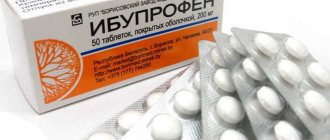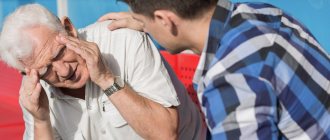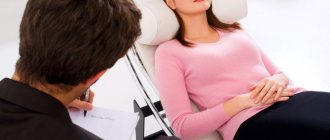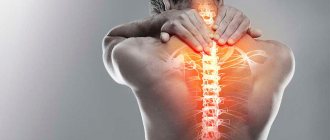Many of us are faced with the problem of neck pain and the inability to find adequate treatment for the symptoms of cervical osteochondrosis. Often the pain is accompanied by signs of VSD and panic attacks. Today it is customary to attribute all problems associated with VSD and cervical osteochondrosis to an unhealthy sedentary lifestyle, constantly spending time at the computer and on the phone. But what should we do if our whole life: work and a considerable part of our leisure time is connected with PCs and gadgets? Accept that we will have to take painkillers for the rest of our days, and that our pain, VSD and panic attacks are incurable? Or radically change your usual lifestyle? Modern neurologists are confident that such extreme measures are not at all necessary, and that modern medicine has found methods to combat VSD and panic attacks in cervical osteochondrosis.
So, if you are worried about neck pain and panic attacks with cervical osteochondrosis, then before choosing the appropriate treatment, you need to understand: why do neck pain and other symptoms attributed to cervical osteochondrosis occur, and why do panic attacks occur?
VSD and cervical osteochondrosis – what to treat?
Are you worried about neck pain? Against the background of constant pain, have you developed increased anxiety, weakness, tearfulness, insomnia and sensitivity to changes in atmospheric pressure? Or maybe you are already experiencing unexpected attacks of rapid heartbeat, numbness in the arms and legs, panic attacks and other symptoms of VSD and cervical osteochondrosis?
If you come to the doctor with such complaints, then most likely you will be diagnosed with “cervical osteochondrosis” and will be recommended to move more, do exercises, undergo a massage course, and if you have complaints of panic attacks with cervical osteochondrosis, you will definitely be prescribed medication.
In addition, if a person is bothered by the above symptoms, then along with and even instead of a diagnosis of osteochondrosis, the patient may be given VSD (vegetative-vascular dystonia), because the symptoms of the two diseases suspiciously coincide.
If you become the unfortunate owner of both diagnoses, then the number of pills you use will double. But will all these methods help get rid of constant pain and panic attacks with cervicothoracic osteochondrosis? Ultimately, many patients discover that they are “incurable.”
Therefore, before taking medications “for all diseases,” you should ask a number of logical questions: what comes first and what exactly needs to be treated – VSD and panic attacks, or cervical osteochondrosis? Why are the symptoms the same, but the treatment is different? How to distinguish VSD and cervical osteochondrosis? We will try to find answers to all these questions.
VSD and panic attacks are disguised as cervical osteochondrosis.
VSD (vegetative-vascular dystonia) is one of the most tricky diseases. VSD and accompanying panic attacks are often disguised as cardiovascular, mental and other health problems. Vegetative-vascular disorder is associated with disturbances in the functioning of the autonomic nodes of the nervous system. These nodes (ganglia) are responsible for the normal functioning of almost all functions of our body: blood circulation, respiration, digestion, reproduction, excretion, metabolism and growth. Therefore, if there is a malfunction in their work, then a general malaise occurs, the variety of components of which ranges from headaches to disorders of the gastrointestinal tract, from mild weakness to a state of loss of consciousness. With VSD and panic attacks, a person does not understand what exactly is hurting him, and numerous examinations do not reveal any pathologies.
In addition, vegetative nodes are located throughout the body, and if they are unhealthy, then a person immediately feels tension or pain in the very part of the body where the unhealthy node is located. That is, if the nerve node in the cervicothoracic region does not work correctly, then first of all this will affect the muscles of the neck. And the first thing the patient will think about is “cervical chondrosis.”
Therefore, if you have a sore neck or are already experiencing panic attacks due to cervical osteochondrosis, then the problem is precisely that VSD, panic attacks and other symptoms are disguised as the so-called “cervical osteochondrosis.” Surprisingly, even such a common component of VSD as panic attacks is beginning to be misinterpreted as a sign of problems with the spine.
Understanding how the autonomic nervous system works also explains why neck pain typically occurs long (perhaps several years) before panic attacks occur. And with the development of panic disorder, patients often complain that neck pain (“cervical chondrosis”) begins to bother them right before a panic attack!
Now it becomes clear why outdated methods of treating cervical osteochondrosis and panic attacks do not bring the long-awaited results, and people live for years with symptoms of cervical osteochondrosis and panic attacks! It’s just that the treatment is aimed completely at the wrong area where it should be - at cervical osteochondrosis and the spine, and not at the VSD and the nervous system.
The diagnosis of cervical osteochondrosis is a myth.
Competent doctors know that the diagnosis of cervical osteochondrosis is one of the most persistent myths in medicine. And those who are less knowledgeable blame a great many problems on osteochondrosis, including panic attacks and symptoms of VSD.
Scientists have long discovered that osteochondrosis is a natural process of aging of the body. Even teenagers have signs of osteochondrosis on x-rays!
We inherited osteochondrosis from our ancient ancestors homo erectus (homo erectus), this is a natural consequence of the evolution of our species and the acquired ability to walk upright.
In fact, osteochondrosis itself does not contribute to the development of VSD and panic attacks and does not give rise to any pronounced clinical complaints. Even neck pain is not a sign of osteochondrosis! Not to mention other symptoms that are attributed to the diagnosis of cervical chondrosis.
What causes panic attacks, neck pain, and other symptoms that are so often attributed to cervical osteochondrosis?
Causes and treatments
According to the latest data, a disorder of the autonomic nervous system can occur against the background of chronic stress, hormonal imbalance, sedentary lifestyle, poor diet, use of tobacco and alcohol products, inflammatory processes and long-term use of medications (including self-medication). One factor is heredity.
The patient’s condition can be corrected using the following non-drug methods:
- Massage and acupuncture. The main goal is relaxation, removing muscle tension and improving blood circulation. Acupuncture has virtually no contraindications and is actively used in the treatment of neuroses and other disorders of the nervous system in adults and children. The beneficial effect of these methods on the patient’s condition has been clinically confirmed, so medical massage in Ufa is one of the most popular procedures.
- Psychotherapy. Often, disorders of the nervous system develop as a result of a person’s mental characteristics. A striking example is workaholism. A person who is completely caught up in work and does not know how to carry out tasks carelessly is in a state of constant stress. Divorce can be no less of a shock (= trigger). Working through your life situation with a psychotherapist allows you to cope not only with the root cause of the disease, but also with its consequences.
You can make an appointment with a cardiologist in Ufa, a neurologist or an orthopedist on our website! Choose a convenient time, leave a comment and wait for our operator to call.
Neck pain and panic attacks - what is the reason?
Let's take a closer look at the reasons why not only panic attacks actually occur with cervical osteochondrosis, but also neck pain.
Firstly, as we found out, the root cause of the disease lies precisely in the disorder of the autonomic nervous system, that is, in the VSD. And cervical osteochondrosis has nothing to do with it.
What happens when the functioning of the autonomic nodes of the nervous system is disrupted? Symptoms such as pain and tension in the neck occur due to muscle hypertonicity, that is, due to persistent muscle spasm in this part of the body. And the cause of the spasm is the excessive production of the neurotransmitter hormones adrenaline and noradrenaline, which are localized precisely in the autonomic nodes of our nervous system.
All other symptoms of cervical chondrosis and panic attacks (tachycardia, headache, numbness of the limbs, fatigue, insomnia, etc.) are standard signs of VSD and have the same causes. [More details: All symptoms and signs of VSD] The fact is that adrenaline and norepinephrine bring our entire body into a state of readiness to “start”. This state is adequate only in extreme situations. In other cases, it only depletes the reserves of our body and our psyche, which leads to nervous breakdowns and panic attacks.
Panic attacks when diagnosed with cervical osteochondrosis are a very common complaint. This is the second “unbearable” symptom of osteochondrosis after back and neck pain. It also happens that a person does not pay attention to muscle pain for a long time and considers it an integral part of his life, and focuses on the disease only when he is overcome by an inexplicable animal fear, fear of death, a condition close to a heart attack - a panic attack. It was then that it turned out that the first sign of the development of a vegetative-vascular disorder was muscle pain, which amounted to “cervical chondrosis” and which led to panic attacks.
Autonomic dysfunction: main types
The following types of autonomic dysfunction are distinguished (not to be confused with vegetative-vascular dystonia (VSD), which is only a manifestation of a number of diseases of the nervous system and other organs):
- Somatophoric disorder . This is a neurosis that manifests itself in the form of symptoms of chronic diseases that the patient does not have. Panic attacks, coughing attacks and shortness of breath of psychogenic origin, digestive problems, periodic dizziness, etc. are possible. This type of dysfunction in most cases is caused by severe or prolonged stress, so it is quite easy to treat.
- Violation of subcortical structures . Damage occurs as a result of previous brain injuries or residual pathology of the central nervous system (often diagnosed in children). The disease is characterized by low blood pressure, fainting, diarrhea and frequent urination.
- Irritation of peripheral autonomic structures , provoked by damage to the sympathetic cervical plexus or urolithiasis.
Autonomic dysfunction, which affects about 70% of adults and 25% of children, always indicates the presence of problems in the body, which means it is a serious reason to consult a specialist. The effectiveness of the prescribed treatment largely depends on the timely making of the correct diagnosis. You can make an appointment with a pediatric neurologist in Ufa by phone.
Cervical osteochondrosis, VSD and panic attacks. Treatment.
People with VSD and panic attacks due to cervicothoracic osteochondrosis often do not know where and how it is treated. Patients undergo courses of massage, acupuncture, psychotherapy, take courses of medications, etc. But at best, it only provides temporary relief from the symptoms of muscle tension and panic attacks. It is important to understand that with “cervical osteochondrosis”, VSD and panic attacks, the symptoms of pain in the neck and back are caused by persistent muscle spasm of the deep muscles of the neck, which the massage therapist’s hands cannot reach, and therefore no massage can solve the problem. And the root cause of pain and panic attacks with VSD and “cervical osteochondrosis” will not be eliminated.
Since the cause of muscle pain and panic attacks during VSD is actually not related to cervical osteochondrosis, treatment should be aimed at the nervous system. The impact of the treatment must be quite deep and powerful and at the same time very careful and precise. Among modern methods of traditional medicine, there is a unique technique that meets these requirements - laser treatment: intravenous laser therapy with red or blue lasers and infrared laser therapy of the skin projection of excited autonomic ganglia.
One of the few places that can offer such treatment and where they have been effectively helping to get rid of panic attacks, VSD and “cervical osteochondrosis” for more than 20 years is the Clinical Center for Autonomic Neurology. The clinic's doctors are qualified neurologists-vegetologists who specialize in the treatment of VSD and panic attacks. If you are diagnosed with “cervicothoracic osteochondrosis”, you can contact us, we will conduct a thorough diagnosis of the state of your autonomic nervous system, and treatment will be aimed specifically at eliminating the source of the disease, that is, returning the nervous system to harmonious functioning, which will relieve you of all symptoms cervical osteochondrosis, VSD and panic attacks.
Muscle tension. Muscle spasm
For the human body to perform work, its muscle tissue in normal condition must be smooth and elastic. Depending on his will, muscle tissue can be equally tense or equally relaxed. But we constantly encounter a situation where, in various places on the human body, areas (or even groups of muscle fibers and entire muscles) may appear in which tension, regardless of the desire of this person, is preserved and maintained. Such areas can be both large and very small; they can be recognized by consciousness as a spasm, tension, or they may not be noticed at all.
What is the harm from muscle tension and spasms?
- The first answer to this question lies on the surface: if a muscle is in spasm, it compresses blood vessels and nerve fibers. As a result, nutrition and energy-information exchange are disrupted both in the tissues of the muscle itself and in those internal organs to which nutrition and innervation are provided by compressed vessels and nerves. For example, in the neck area the vagus nerve is pinched; impulses do not pass through it to the pancreas, which causes a disruption of the innervation of the organ with corresponding enzymatic disorders of the gastrointestinal tract.
- The second negative result: a spasmed muscle is a contracted muscle; maintaining it in a tense state requires ATP - certain energy costs. That is, maintaining the muscle in a state of tension consumes the body’s own energy, and the resulting tension not only does not bring benefit, but also harms the body (see point 1). Considering that the areas in which muscle tension has arisen can be quite extensive, and the tension is maintained constantly (even during sleep), the body’s energy expenditure on irrational and harmful work can be quite significant.
There is a third negative consequence, which we will talk about a little later.
Symptoms
Typically, when examined by a doctor, trigger (pain) zones can be found in the erector spinae or levator scapula muscle, in the trapezius muscle, as well as in some others. With muscle tension, the patient may feel:
- pain of aching, itching, pressing nature
- increased or decreased almost constant pain
- reflection of pain in the shoulder, eye, head
- inability to perform full range of arm movements or turn the head.
Causes
The main causes of muscle spasms are:
- osteochondrosis, as well as its manifestations, expressed in the form of protrusions, herniated intervertebral discs
- injuries and bruises of the spine, in which muscle tension occurs in response to pain and a trigger syndrome develops
- static muscle tension of a long-term nature, which can occur due to incorrect posture of a person sitting at a table or working at a computer, when carrying a bag on one shoulder (when one shoulder becomes higher than the other)
- emotional stress causing increased muscle tone.
Why do muscle tension and spasms occur?
Muscle spasms are painful, convulsive muscle contractions that occur involuntarily during or immediately after exercise.
The cause of spasms depends on various reasons and has not yet been fully studied. However, there are some common reasons that determine the nature of the origin of muscle tension.
Electrolytes
The hydration state of the human body plays a key role in the likely occurrence of muscle spasms. At the gym, you may notice people consuming vitamin drinks while doing exercises. They do this for a reason.
Vitamin drinks contain optimally balanced concentrations of sodium, potassium and calcium. These microelements have a beneficial effect on the functioning of muscles and nerves. If the balance of these electrolytes is disturbed (which is possible when a person sweats heavily), problems can arise.
The same thing can happen if you start drinking a lot of water during exercise. Many people do a set and immediately drink water, do the next set and drink again. At the same time, they are sure that in this way they are helping their body.
Everyone knows that the human body is three-quarters water. During intense exercise, sodium is released along with sweat, which does not replace anything. When a person drinks water, he replaces one released liquid with another, which is not similar - it lacks a key mineral component. This may be the reason why muscle function deteriorates.
In addition, when exercising in a very hot room, this process is complicated: not only does the person sweat more, but the heat also negatively affects the muscles. The result is weakness and fatigue.
Calcium level
Another reason for the appearance of blocks is low levels of calcium in the body. If calcium concentration decreases, the amount of intracellular fluid that surrounds muscles and nerves decreases. As a result, the nerve endings are subject to excessive irritation, and this, in turn, leads to spasms.
Muscle fatigue
After muscle tension, a period of relaxation begins, lasting longer than the contraction itself. But this relaxation process is based on sensory feedback that occurs between the spinal cord and muscles and connects the tendons and neuromuscular spindles.
If muscles are tired, they contract. This increases the load on the neuromuscular spindles and decreases the load on the tendons. If this happens at the same time, the process of proper muscle compression/relaxation is disrupted, which leads to spasm.
Large amount of carbohydrates
If a person follows a low-carbohydrate diet, this may affect the state of the muscular system. Therefore, it is necessary to remember that such a diet can lead to muscle spasms and avoid overexertion.
Where do muscle spasms come from?
Let's consider this example: with osteochondrosis, growths of bone tissue (having sharp edges) are formed along the edges of the intervertebral discs, the so-called osteophytes. These growths can easily injure surrounding tissues and nerves when making awkward turns or sudden movements. As a result of pain, the brain sends a command to tighten the surrounding muscles to protect the injured area. The stronger the pain, the greater the muscle tension. At the same time, the stronger the muscle tension, the more painful it is. A trigger syndrome occurs.
Two conclusions follow from this:
- In order to put a displaced vertebra in place, you must first relax the surrounding muscles
- muscle spasm is a response to pain.
Another example: a fracture occurred, and the surrounding muscles tensed in response to pain. The bone subsequently healed, but muscle spasm remained at the fracture site for life. It compresses blood vessels and nerves, thereby limiting mobility.
Thus, the first reason for the formation of muscle spasms can be attributed to all kinds of injuries, in which the muscles tense in response to pain and a trigger syndrome develops. For this reason, the formation of spasms can occur from birth due to birth injuries. In general, childbirth is very stressful for both the child’s body and the mother’s body. They can be very traumatic. Spasms of the cervical muscles (especially the suboccipital muscles), which disrupt the nutrition of the brain, very often occur in most people and persist for life as a result of birth injuries.
The second reason for the formation of muscle spasms is prolonged static muscle tension, which can occur when a schoolchild sits incorrectly at a desk, a person at a computer, or when carrying a bag on the same shoulder (in this case, one shoulder becomes higher than the other). If such tension is maintained for a long time, the phenomenon of inhibition occurs, the tense state for the cells becomes habitual. If a specifically tense area is not relaxed and mobilized, tension will remain in it constantly.
A third cause of muscle spasms may be emotional stress. To overcome a stressful situation at the moment of its occurrence, the body mobilizes all internal resources: muscle tone increases, heart rate accelerates, certain hormones are released into the blood, digestion slows down. This reaction is required for the survival of the organism - to ensure an appropriate reaction in threatening conditions. After overcoming the threat, the body returns to normal functioning and relaxes. But under certain circumstances there is no return to normal. This leads to the fact that a person seems to be in a state of stress all the time; muscle tension, which is characteristic of a stressful situation, becomes chronic for him. At the same time, the presence of muscle tone during chronic stress is far from its only negative consequence. In addition, disorders of the cardiovascular and digestive systems develop (up to the occurrence of serious diseases), a person becomes irritable, and his performance decreases.
When should you consult a doctor?
- If the muscles are inactive and pain is felt during the first three days.
- If muscle spasms in the back or neck are accompanied by numbness, tingling or weakness, you should consult a doctor immediately.
How to avoid recurrence of blocks, muscle tension and spasms.
The best way to prevent recurrent spasms is to keep the muscles strong, flexible and adequately conditioned. Before starting active physical exercise, do not forget about stretching and perform exercises to strengthen your muscles. Avid athletes should definitely consult with a coach who can correct the movement mechanisms that are necessary for this sport.











